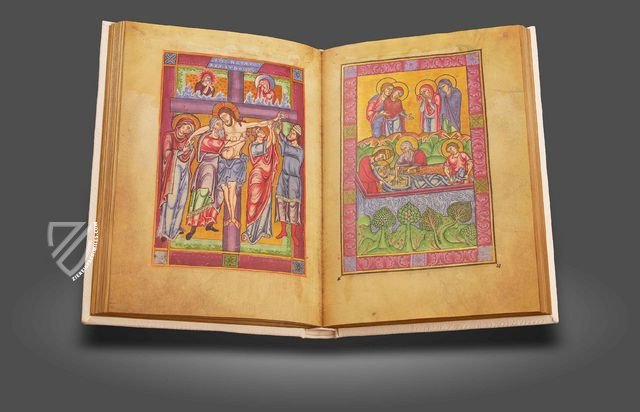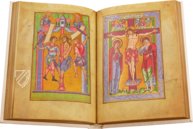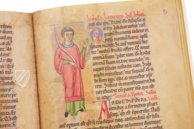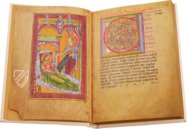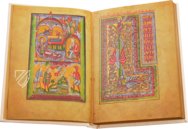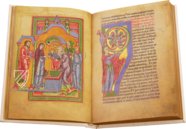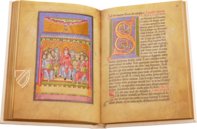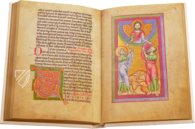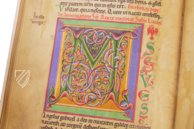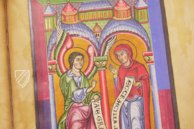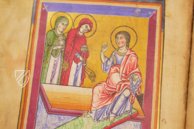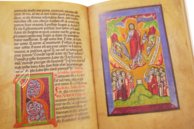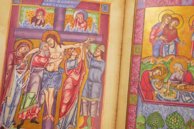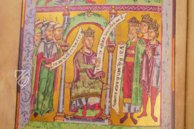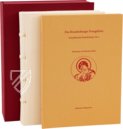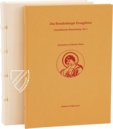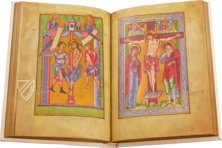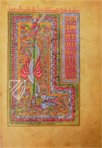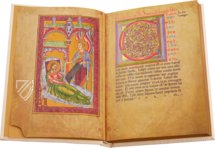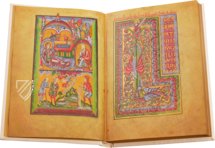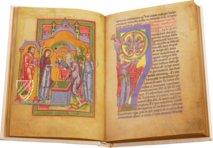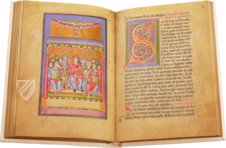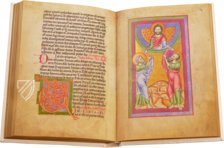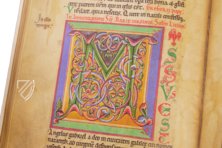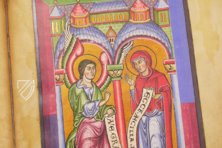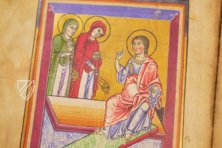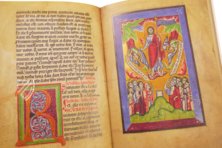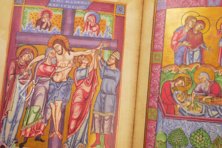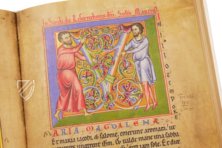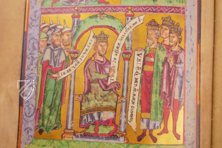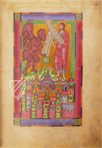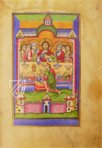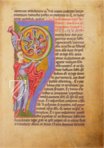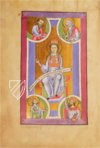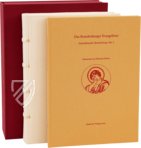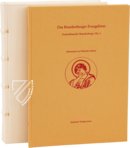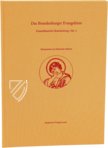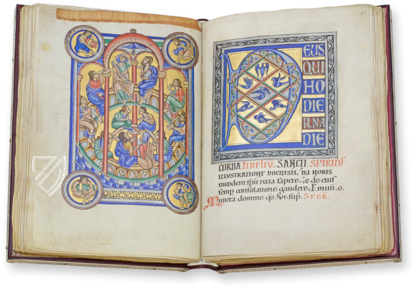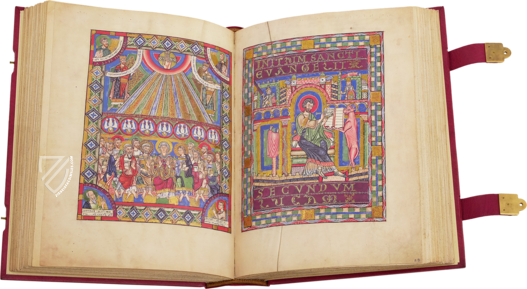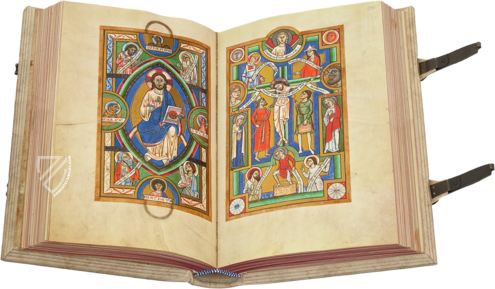Brandenburg Evangeliary
(7,000€ - 10,000€)
In the early 13th century, Brandenburg was on the edges of Christendom; the Eastern Baltic was still largely pagan and facing the wrath of the Northern Crusades. Immigration from the south fueled the growth of cities across what is now northern Germany and cathedrals were being erected. A scriptorium in the city of Magdeburg was commissioned with the creation of the splendid manuscript at hand by the Premonstratensians, a religious order consisting of Canons Regular engaged in preaching instead of monks. The manuscript is a magnificent example of the Late Romanesque style in Germany exhibiting artistic influences from across Europe. Full-page miniatures and large historiated initials are executed with great mastery in a wonderful variety of bright, opaque colors as well as gold and silver leaf. More than 800 years later, the impressive manuscript still resides in the treasury of Brandenburg Cathedral.
Brandenburg Evangeliary
One of the last and greatest artistic accomplishments of German Romanesque art: the Brandenburg Evangeliary was created ca. 1210 in the city of Magdeburg. It was commissioned by the Brandenburg chapter of the Premonstratensians, a religious order consisting of Canons Regular engaged in preaching instead of monks, and has remained in Brandenburg Cathedral’s treasury for all 800+ years of its existence. It is in fact one of the few manuscripts to spend its entire life in its original location, although the jeweled binding was lost in the course of World War II. Gorgeous full-page miniatures and large historiated initials, some of which fuse figure and letters, are created using rich opaque colors accented with gold and silver leaf. Its splendid combination of contemporary styles makes it a landmark of medieval German illumination.
The Pride of Brandenburg Cathedral
This manuscript is part of a tradition of large Gospel Books intended for public display, usually in cathedrals or large abbeys. It is also a gorgeous testament to the period, when the Northern Crusades were engaged in the conversion of pagan Slavs living in the region of the Eastern Baltic, and when modern northern Germany was experiencing an influx of settlers from the south. It was doubtless meant to impress both the faithful and the unconverted. As an evangeliary, the text consists of readings from the Gospels that were arranged in accordance with the liturgical year, arranged for the purpose of being recited during Mass. The picture cycle depicts scenes from the Life of Christ going up through the Pentecost presented in richly colored full-page miniatures with gold leaf.
An Impressive Mix of Styles
Although distinctly German in character, artistic influences from across Europe are evident in the 18 full-page miniatures, one full-page historiated initial, ten large historiated initials, and numerous other initials all painted with intense, bright colors embellished with gold and silver leaf. The glimmering gold backgrounds that give a timeless and spaceless feeling to the miniatures and historiated initials is derived from Byzantine art, as are certain iconographic forms. The tendril initials are inspired by the “Channel Style”, a Romanesque fusion of English and northern French styles. Meanwhile, Italian influences can also be seen in many of the initials and frames that incorporate acanthus, palmette, and ivy motifs. The manuscript could even be considered proto-Gothic because of its more naturalistic body posturing highlighted by a skillful play of light and shadow. Furthermore, jagged fall of folds, rocky edges, and similar stylized elements seem to foretell the coming Zackenstil, a “jagged style” of early German Gothic art. It is precisely the manuscript’s hard-to-define hybrid style that, along with the extremely high quality of its execution and quality of its materials, makes the Brandenburg Evangeliary a milestone of German illumination.
Codicology
- Alternative Titles
- Brandenburger Evangelistar
- Size / Format
- 218 pages / 33.6 × 24.0 cm
- Origin
- Germany
- Date
- Ca. 1210
- Epochs
- Style
- Language
- Script
- Protogothic minuscule
- Illustrations
- 18 full-page miniatures, one full-page ornamental initial, ten large miniature-like ornamental initials, numerous multi-line gold initials on coloured ground and coloured initials on gold ground, large areas of gold leaf, shiny silver, intensively bright colours
- Content
- Pericopes - Texts for the liturgical year beginning with Christmas
- Patron
- Brandenburg Cathedral chapter
Brandenburg Evangeliary
The Last Temptation of Christ
After Satan tempts Jesus in the desert and on the pinnacle of the Temple, he takes Jesus to the top of a mountain to offer Him dominion over all the earthly kingdoms, but this appeal to pride and ambition for power was useless against the King of Kings. While Jesus is depicted standing upright with his serene gaze fixed slightly upward, Satan is a squat, hairy, winged beast who looks directly out from the page with a pitiful expression of frustration and defeat on his face.
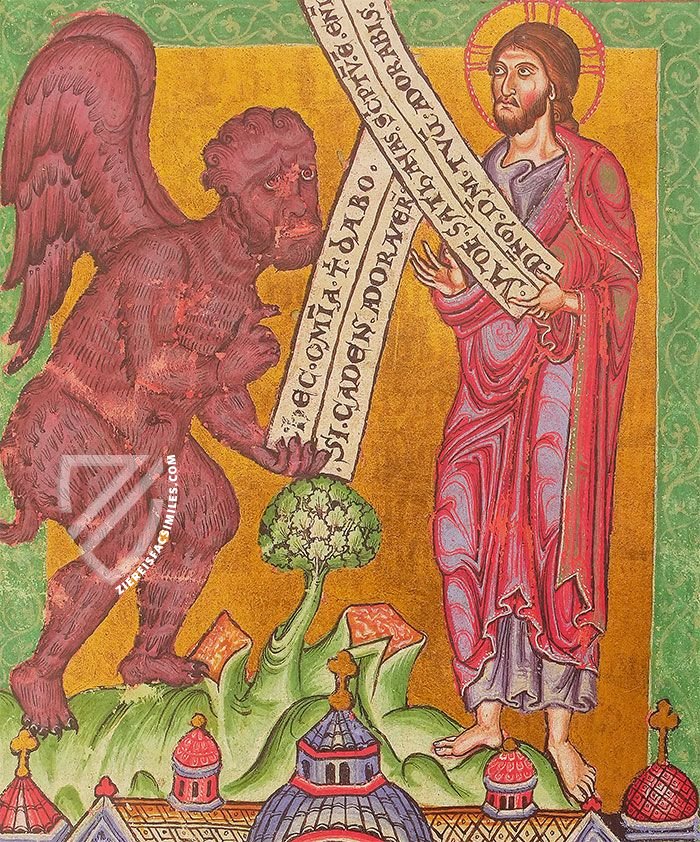
Brandenburg Evangeliary
Historiated “L” Initial
Appearing across from two miniatures of the Nativity and the Annunciation to the Shepherds, this splendid gold, red, green, and blue full-page “L” initial introduces the first line of the Book of Matthew: Liber generationis Jesu Christi filii David, filii Abraham or “The book of the genealogy of Jesus Christ, the Son of David, the Son of Abraham”.
Rather than having a typical Jesse Tree, only Jesus is shown sitting at the top of the initial with a banderole reading Liber generationis. Surrounded by acanthus leaves, the swirling tendrils contain three dragons, a small one below and to the left of Christ and two large dragons battling one another at the base. Intricate initials with zoomorphic figures, dragons in particular, were borrowed from Insular art.
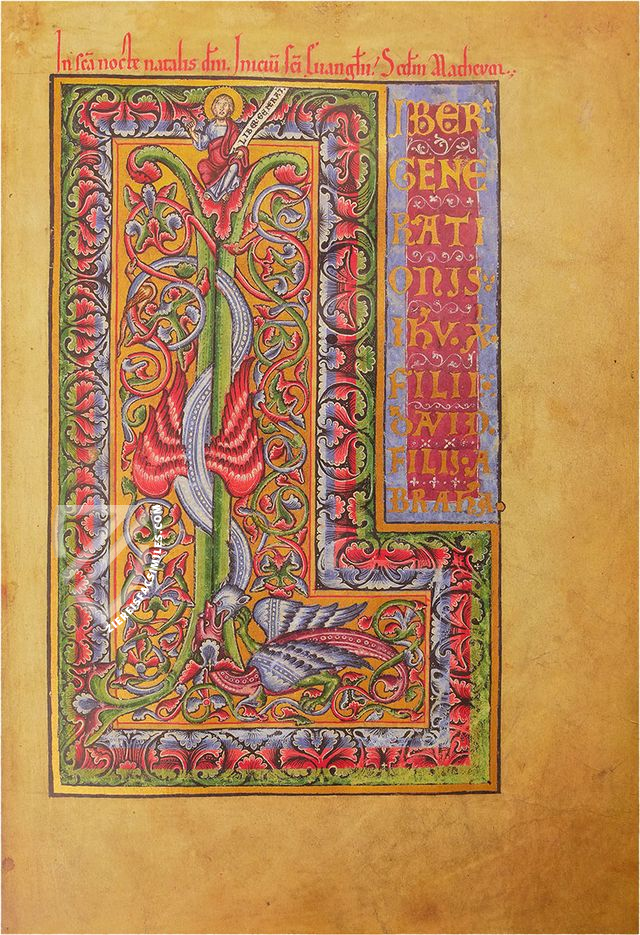
#1 Das Brandenburger Evangelistar
Language: German
(7,000€ - 10,000€)
- Treatises / Secular Books
- Apocalypses / Beatus
- Astronomy / Astrology
- Bestiaries
- Bibles / Gospels
- Chronicles / History / Law
- Geography / Maps
- Saints' Lives
- Islam / Oriental
- Judaism / Hebrew
- Single Leaf Collections
- Leonardo da Vinci
- Literature / Poetry
- Liturgical Manuscripts
- Medicine / Botany / Alchemy
- Music
- Mythology / Prophecies
- Psalters
- Other Religious Books
- Games / Hunting
- Private Devotion Books
- Other Genres
- Afghanistan
- Armenia
- Austria
- Belgium
- Belize
- Bosnia and Herzegovina
- China
- Colombia
- Costa Rica
- Croatia
- Cyprus
- Czech Republic
- Denmark
- Egypt
- El Salvador
- Ethiopia
- France
- Germany
- Greece
- Guatemala
- Honduras
- Hungary
- India
- Iran
- Iraq
- Israel
- Italy
- Japan
- Jordan
- Kazakhstan
- Kyrgyzstan
- Lebanon
- Liechtenstein
- Luxembourg
- Mexico
- Morocco
- Netherlands
- Palestine
- Panama
- Peru
- Poland
- Portugal
- Romania
- Russia
- Serbia
- Spain
- Sri Lanka
- Sweden
- Switzerland
- Syria
- Tajikistan
- Turkey
- Turkmenistan
- Ukraine
- United Kingdom
- United States
- Uzbekistan
- Vatican City
- A. Oosthoek, van Holkema & Warendorf
- Aboca Museum
- Ajuntament de Valencia
- Akademie Verlag
- Akademische Druck- u. Verlagsanstalt (ADEVA)
- Aldo Ausilio Editore - Bottega d’Erasmo
- Alecto Historical Editions
- Alkuin Verlag
- Almqvist & Wiksell
- Amilcare Pizzi
- Andreas & Andreas Verlagsbuchhandlung
- Archa 90
- Archiv Verlag
- Archivi Edizioni
- Arnold Verlag
- ARS
- Ars Magna
- ArtCodex
- AyN Ediciones
- Azimuth Editions
- Badenia Verlag
- Bärenreiter-Verlag
- Belser Verlag
- Belser Verlag / WK Wertkontor
- Benziger Verlag
- Bernardinum Wydawnictwo
- BiblioGemma
- Biblioteca Apostolica Vaticana (Vaticanstadt, Vaticanstadt)
- Bibliotheca Palatina Faksimile Verlag
- Bibliotheca Rara
- Boydell & Brewer
- Bramante Edizioni
- Bredius Genootschap
- Brepols Publishers
- British Library
- C. Weckesser
- Caixa Catalunya
- Canesi
- CAPSA, Ars Scriptoria
- Caratzas Brothers, Publishers
- Carus Verlag
- Casamassima Libri
- Centrum Cartographie Verlag GmbH
- Chavane Verlag
- Christian Brandstätter Verlag
- Circulo Cientifico
- Club Bibliófilo Versol
- Club du Livre
- CM Editores
- Collegium Graphicum
- Collezione Apocrifa Da Vinci
- Comissão Nacional para as Comemorações dos Descobrimentos Portugueses
- Coron Verlag
- Corvina
- CTHS
- D. S. Brewer
- Damon
- De Agostini/UTET
- De Nederlandsche Boekhandel
- De Schutter
- Deuschle & Stemmle
- Deutscher Verlag für Kunstwissenschaft
- DIAMM
- Droz
- E. Schreiber Graphische Kunstanstalten
- Ediciones Boreal
- Ediciones Grial
- Ediclube
- Edições Inapa
- Edilan
- Editalia
- Edition Deuschle
- Edition Georg Popp
- Edition Leipzig
- Edition Libri Illustri
- Editiones Reales Sitios S. L.
- Éditions de l'Oiseau Lyre
- Editions Medicina Rara
- Editorial Casariego
- Editorial Mintzoa
- Editrice Antenore
- Editrice Velar
- Edizioni Edison
- Egeria, S.L.
- Eikon Editores
- Electa
- Emery Walker Limited
- Enciclopèdia Catalana
- Eos-Verlag
- Ephesus Publishing
- Ernst Battenberg
- Eugrammia Press
- Extraordinary Editions
- Fackelverlag
- Facsimila Art & Edition
- Facsimile Editions Ltd.
- Facsimilia Art & Edition Ebert KG
- Faksimile Verlag
- Feuermann Verlag
- Folger Shakespeare Library
- Franco Cosimo Panini Editore
- Friedrich Wittig Verlag
- Fundación Hullera Vasco-Leonesa
- G. Braziller
- Gabriele Mazzotta Editore
- Gebr. Mann Verlag
- Gesellschaft für graphische Industrie
- Getty Research Institute
- Giovanni Domenico de Rossi
- Giunti Editore
- Graffiti
- Grafica European Center of Fine Arts
- Guido Pressler
- Guillermo Blazquez
- Gustav Kiepenheuer
- H. N. Abrams
- Harrassowitz
- Harvard University Press
- Helikon
- Hendrickson Publishers
- Henning Oppermann
- Herder Verlag
- Hes & De Graaf Publishers
- Hoepli
- Holbein-Verlag
- Houghton Library
- Hugo Schmidt Verlag
- Idion Verlag
- Il Bulino, edizioni d'arte
- ILte
- Imago
- Insel Verlag
- Instituto de Estudios Altoaragoneses
- Instituto Nacional de Antropología e Historia
- Istituto dell'Enciclopedia Italiana - Treccani
- Istituto Ellenico di Studi Bizantini e Postbizantini
- Istituto Geografico De Agostini
- Istituto Poligrafico e Zecca dello Stato
- Italarte Art Establishments
- Jan Thorbecke Verlag
- Johnson Reprint Corporation
- Josef Stocker
- Josef Stocker-Schmid
- Jugoslavija
- Karl W. Hiersemann
- Kasper Straube
- Kaydeda Ediciones
- Kindler Verlag / Coron Verlag
- Kodansha International Ltd.
- Konrad Kölbl Verlag
- Kurt Wolff Verlag
- La Liberia dello Stato
- La Linea Editrice
- La Meta Editore
- Lambert Schneider
- Landeskreditbank Baden-Württemberg
- Leo S. Olschki
- Les Incunables
- Liber Artis
- Library of Congress
- Libreria Musicale Italiana
- Lichtdruck
- Lito Immagine Editore
- Lumen Artis
- Lund Humphries
- M. Moleiro Editor
- Maison des Sciences de l'homme et de la société de Poitiers
- Manuscriptum
- Martinus Nijhoff
- Maruzen-Yushodo Co. Ltd.
- MASA
- Massada Publishers
- McGraw-Hill
- Metropolitan Museum of Art
- Militos
- Millennium Liber
- Müller & Schindler
- Nahar - Stavit
- Nahar and Steimatzky
- National Library of Wales
- Neri Pozza
- Nova Charta
- Oceanum Verlag
- Odeon
- Orbis Mediaevalis
- Orbis Pictus
- Österreichische Staatsdruckerei
- Oxford University Press
- Pageant Books
- Parzellers Buchverlag
- Patrimonio Ediciones
- Pattloch Verlag
- PIAF
- Pieper Verlag
- Plon-Nourrit et cie
- Prestel Verlag
- Princeton University Press
- Prisma Verlag
- Priuli & Verlucca, editori
- Pro Sport Verlag
- Propyläen Verlag
- Pytheas Books
- Quaternio Verlag Luzern
- Reales Sitios
- Recht-Verlag
- Reichert Verlag
- Reichsdruckerei
- Reprint Verlag
- Riehn & Reusch
- Roberto Vattori Editore
- Rosenkilde and Bagger
- Roxburghe Club
- Salerno Editrice
- Saltellus Press
- Sandoz
- Sarajevo Svjetlost
- Schöck ArtPrint Kft.
- Schulsinger Brothers
- Scolar Press
- Scrinium
- Scripta Maneant
- Scriptorium
- Shazar
- Siloé, arte y bibliofilia
- SISMEL - Edizioni del Galluzzo
- Sociedad Mexicana de Antropología
- Société des Bibliophiles & Iconophiles de Belgique
- Soncin Publishing
- Sorli Ediciones
- Stainer and Bell
- Studer
- Styria Verlag
- Sumptibus Pragopress
- Szegedi Tudomànyegyetem
- Taberna Libraria
- Tarshish Books
- Taschen
- Tempus Libri
- Testimonio Compañía Editorial
- Thames and Hudson
- The Clear Vue Publishing Partnership Limited
- The Facsimile Codex
- The Folio Society
- The Marquess of Normanby
- The Richard III and Yorkist History Trust
- Tip.Le.Co
- TouchArt
- TREC Publishing House
- TRI Publishing Co.
- Trident Editore
- Typis Regiae Officinae Polygraphicae
- Union Verlag Berlin
- Universidad de Granada
- University of California Press
- University of Chicago Press
- Urs Graf
- Vallecchi
- Van Wijnen
- VCH, Acta Humaniora
- VDI Verlag
- VEB Deutscher Verlag für Musik
- Verlag Anton Pustet / Andreas Verlag
- Verlag Bibliophile Drucke Josef Stocker
- Verlag der Münchner Drucke
- Verlag für Regionalgeschichte
- Verlag Styria
- Vicent Garcia Editores
- W. Turnowski Ltd.
- W. Turnowsky
- Waanders Printers
- Wiener Mechitharisten-Congregation (Wien, Österreich)
- Wissenschaftliche Buchgesellschaft
- Wissenschaftliche Verlagsgesellschaft
- Wydawnictwo Dolnoslaskie
- Xuntanza Editorial
- Zakład Narodowy
- Zollikofer AG

